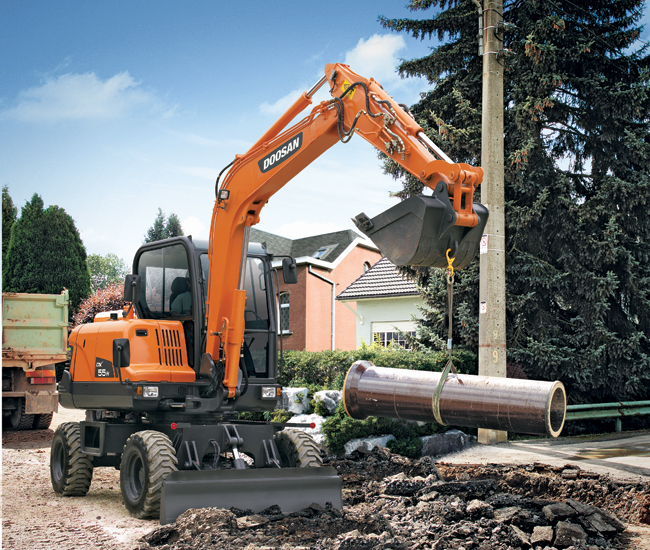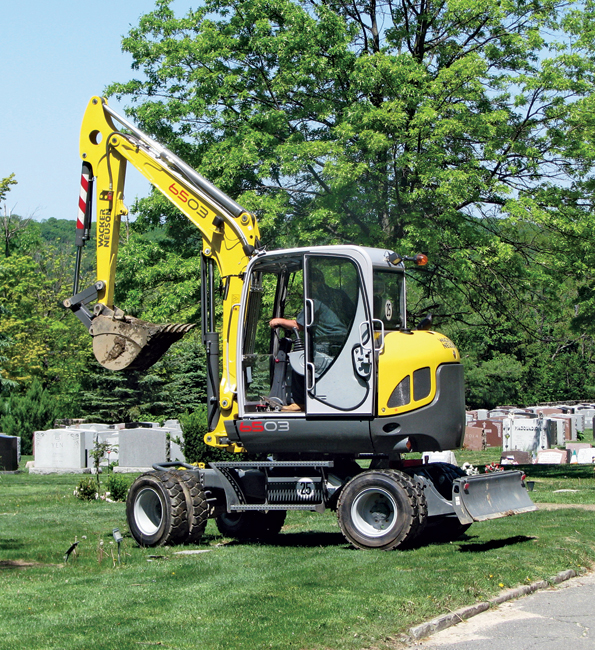Dig’n’Roll
When Joe Contractor needs a dedicated digging machine, he turns to an excavator. It’s a tool devoted to putting precise holes in the ground. But what if Joe needs a digging machine that can also quickly travel from jobsite to jobsite?
In the past, construction professionals would settle for a less productive digger like a backhoe loader or a tractor with a digging attachment, because wheels increased cycle times over the slow and steady march of an excavator’s dedicated track undercarriage. But today there is another option rarely explored by North American contractors — the excavator that rolls from job to job using tires.

“Wheeled excavators can handle the same tasks as its tracked counterparts,” explains Marcus Auerbach, director of compact equipment at Wacker Neuson. “The advantage of wheeled excavators is that they are very mobile and do not rely on a trailer for transportation on the job. Time is often critical, because excavators only make money when they are digging. It takes quite a bit of time to prepare a tracked excavator for transport, load it on the trailer, chain it down properly on all four sides, haul it, unchain the machine and finally unload it. This process can easily take up to an hour or more. In the same time, a wheeled excavator has already traveled 25 miles.”
That sort of mobility is nothing new to Wacker Neuson’s home continent of Europe, where wheeled excavators have grown up over decades working the busy, congested streets of countries like Germany and the United Kingdom. Today, other companies like Doosan, Volvo, Caterpillar, Komatsu, John Deere, Terex and JCB all manufacture wheeled excavators for the world market, but very few are actually sold in North America. In fact, most of the wheeled excavators sold in the United States are pretty big units — in the 16- to 20-metric ton class (compact excavators range from 1 to 8 metric tons). But manufacturers are seeing a big potential for smaller wheeled excavators, as mobility, cost of ownership and operation in tight urban areas increases.
Compact wheeled excavators can take on the same jobs as a regular compact excavator or as a backhoe loader (although initial purchase price is significantly more expensive). Traveling up to 25 mph, these dedicated diggers with wheels emphasize dig-and-run projects, operator comfort and all-around visibility. Municipalities, highway contractors, urban utility professionals, commercial site developers, right-of-way experts and rental houses are discovering how wheels can increase the speed of digging operations.
“When considering a wheeled excavator, decide how it will be used,” says Chad Ellis, product manager with Doosan Infracore Construction Equipment. “If primary applications will be urban construction or utility work, buy or rent a machine with a dozer blade on one end and outriggers on the other. If primary applications will be road work, ditch cleaning or picking and placing materials, then a machine with outriggers on all four corners would be more suitable. Also consider what attachments you may need.”

Today, Doosan offers four wheeled excavators to the North American market, including its smallest 5.5-metric ton DX55W (along with the bigger DX140W, DX190W and DX210W). These rolling excavation machines are engineered similar to their tracked cousins with a long digging arm and a cab or ROPS enclosure. With a dig depth ranging from 11 to 20 ft and a travel speed usually between 19 to 25 mph, wheeled excavators are engineered for quick dig-and-run jobs. Their defining traits start with the chassis and wheels. Front axles offer wide oscillating and steering angles for transport, but can be locked rigid for better digging and lifting performance. Outriggers can be actuated to stabilize the machine on uneven and precarious surfaces. With the stabilizers down, operators don’t lose as much lifting capacity over the side as you do on a regular excavator — important when doing road work.
Wheeled excavators usually come with a formidable dozer blade on the front that can perform serious push-and-drag work, as well as tracked excavators; the dozer blade also serves as another stabilizer during digging operations. Both one- and two-piece booms in a variety of sizes are options for most units as well. Use a two-piece hydraulically adjustable boom to greatly enhance the lifting capacity of the machine by keeping the load close to the excavator. Stick to a mono-boom for extra reach-and-lift capacity when performing long-distance work (it utilizes light weight construction for extra lift).
“Think outside of the box,” suggests Auerbach. “Think about what has been used traditionally and consider new ways. Compact wheeled excavators offer unique advantages and have the potential to improve the productivity and bottom line of a contractor significantly. In urban environments also consider the pair of a wheeled excavator with a wheeled dumper. The combination allows you to excavate dirt directly into the dumper and haul it away to a site close by without the need of a large dump truck and without piling up next to the trench.”

Because they are premium machines, wheeled excavators usually have posh operating environments and big price tags. High-performance air conditioned and heated cabs, tilt steering wheels, air cushioned seats, satellite radio, tilting and telescoping control stands, back and forward cameras and rows of gauges, system checks and operation options are usually integrated into the work cab. Attachments are plentiful as well. Ditching buckets are popular for road work. Mowers attack right-of-way maintenance. Augers dig for fence applications. Vibratory compaction plates spearhead backfilling and hydraulic breakers streamline demolition. Quick couplers and rotating couplers expand each unit’s versatility.
Application and terrain will help you decide whether wheels or tracks fit your operations. Of course, wheeled excavators do have their disadvantages. The large footprint of a track undercarriage has better overall stability on the ground vs. a wheeled excavator. When it comes to uneven ground conditions, tracks always win over air-filled tires and stabilizers. Also, the constant use of the stabilizers to lift or dig is going to add time to the cycle and reduce or eliminate some of the mobility advantage of a wheeled machine. Increased mobility is also a reason manufacturers don’t concentrate on producing zero tail swing or reduced radius wheeled excavators. Stability is critical to do work, and wheeled excavator designs are inherently less stable than the track machines.
Wheeled models are also fairly expensive, ranging in price from $80,000 to $140,000, which is a lot of money upfront. But some of those costs can be mitigated with the increased production of a wheeled unit — especially when it comes to transportation costs. Residential contractors enjoy the fact that the machine can be moved around subdivisions quickly. Utility companies need a unit that can drive to a broken water or sewer line within minutes. Road and bridge contractors need mobility in a 10- or 20-mile work radius without tying up a truck and trailer.
“I think many general contractors would find good use for wheeled excavators if they would give them a try,” says Ellis. “A wheeled excavator can be driven wherever it needs to work. This saves considerably on transportation expense, which will more than offset the higher purchase price over time. And a wheeled excavator saves on the cost of repairing asphalt or other surfaces that would be damaged by a tracked excavator.”
It’s hard not to appreciate the advantages. And while only a few companies like Wacker Neuson, Terex and Doosan make small wheeled excavators today, manufacturers see more interest in the segment as Europe’s and Asia’s confined space work environments increase in North America.
“We see a big potential because other machines are simply too big,” says Auerbach. “Jobs that require a quick in and out or jobs that require frequent movement of the machine down the road are clearly calling for a machine on wheels.”
Keith Gribbins is managing editor of Compact Equipment, based in Peninsula, Ohio.
CARB Launches Loan Program to Build Cleaner Off-Road Diesel Fleets
California continues its quest to become the cleanest state in the nation. In May, the California Air Resources Board (CARB) announced it would be offering $5 million from the federal government’s American Recovery and Reinvestment Act to assist California small businesses replace, repower or retrofit their off-road diesel vehicles. CARB has partnered with the California Pollution Control Financing Authority, part of the State Treasurers Office, to offer loan assistance to help small businesses upgrade their off-road diesel vehicles used in construction, agriculture, mining and industrial operations. The objective of the program is to encourage early compliance with CARB’s off-road diesel regulation.
“Small businesses can take advantage of the loan program and modernize their vehicles improving air quality and public health ahead of state deadlines,” says CARB chairman Mary D. Nichols. “This funding program comes at a time when small businesses are trying to survive in a tough economy.”
ARB forecasts 320 loans will be issued under this loan assistance program to small businesses who cannot obtain financing for upgrading their off-road vehicles through conventional methods. “Assisting small businesses is an important part of getting California’s economy back on track,” says State Treasurer Bill Lockyer, chair of CPCFA. “This funding will help us achieve that goal and at the same time help rid the air of harmful pollutants.” Eligibility requirements for the loan assistance program are:
- The company must be a small business with 500 or fewer employees;
- The majority of the employees must live in California;
- Most of the business operation takes place in California;
- Fleets of all sizes are eligible; and,
- The business owner has a Diesel Off-Road On-line Reporting System (DOORS) identification number.
The California Pollution Control Financing Authority will process the loans through its existing California Capital Access Program, or CalCAP. Interested borrowers can apply for a loan by completing an application at a participating CalCAP Off-Road Lender. The lenders determine the applicant’s eligibility for a loan. For vehicle purchase or engine replacements, the borrower or dealer must provide to CalCAP verification of destruction of the older engine within 90 days of the loan date. For more information on the off-road vehicle loan program, go to www.arb.ca.gov or call 1-866-6DIESEL.




